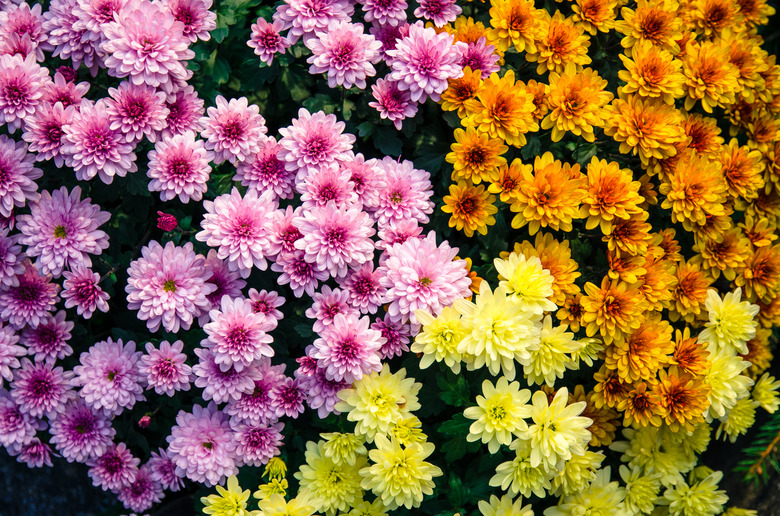How To Care For Mums In The Summer
We may receive a commission on purchases made from links.
You probably know chrysanthemums (Chrysanthemum spp.), or mums, as familiar plants covered with colorful flowers that brighten the fall landscape. Although often seen in plant nurseries as container-grown specimens ready to flower in early fall, they are hardy perennial plants, so care for mums in the summer is important if you plant them in the garden.
The species commonly called hardy garden mum (Chrysanthemum x morifolium), for example, grows as a perennial in U.S. Department of Agriculture plant hardiness zones 5 through 9. When planted in spring within their growing range and given the right kind of summer care, mums become well-established and usually return each spring to bring their bright colors to the fall garden.
Watering and Feeding Mums
Watering and Feeding Mums
If you plant young mums in spring or overwintered mums showing new growth, then keep them well-watered during late spring and into the summer months. Regular supplies of moisture are especially important for them during hot, dry weather. Water the plants deeply whenever the top 1 inch of their soil feels dry to the touch. During dry spells, a good rule of thumb is to water once each week, but water at each plant's base to keep foliage dry and discourage the growth of fungus.
Care for mums in the summer is easier with mulch. Adding 2 or 3 inches of organic mulch such as shredded bark on the soil surface around the plants helps conserve soil moisture. Keep the mulch back a bit from each plant's center to help prevent fungal diseases.
Feeding, or fertilizing, mums during their growing season from late spring through summer also helps them put out strong growth and set lots of flower buds. Use a water-soluble, high-phosphorous fertilizer formula such as 5-10-5 to boost blooming, diluting the fertilizer by mixing 1 tablespoon in 1 gallon of water, or according to label directions if they vary from this mixingrate. Apply the fertilizer solution once each month during the growing season for the best results, using it instead of a regular watering.
Pinching Back for Bushiness
Pinching Back for Bushiness
If you plant young mum plants in the garden in spring or grow mums from the previous season, then pinch off the tips on their new stems when they are about 6 inches long. Use your fingertips or pruning shears that you wipe with rubbing alcohol after each cut to prevent the spread of plant diseases.
When new side shoots, called laterals, sprout at each trimmed tip, also pinch them back when they're 6 to 8 inches long. Continue trimming back new shoots as they appear until midsummer. Then let the plants grow without further cutting. This approach produces compact but bushy mums with masses of flower buds.
Avoiding Mum Problems
Avoiding Mum Problems
Mums are usually trouble-free and simple to grow, but they may develop a fungal disease if grown in overly wet soil or humid environments. Part of caring for mums in the summer is preventing and addressing these issues. You may see white powder from powdery mildew on their leaves, or grayish deposits on the leaves and stems caused by gray mold.
Keeping plants well-spaced for good air circulation and watering each plant at its base helps avoid these fungal problems. If you see signs of fungus, though, it's best to remove the affected parts of the plants, cutting into healthy tissue below the damaged parts. Discard all plant debris on a regular basis because it can harbor fungal pathogens. If a fungal problem is severe, remove mulch from under the plants to help the plants dry quickly after rain or watering.
Mums are usually pest-free, but small, mahogany-tinted insects called chrysanthemum aphids might become a problem, sucking plant juices and slowing plant growth. A chrysanthemum aphid nymph is 2/100 to 4/100 inch long; an adult without wings is 6/100 inch long, and an adult with wings can grow almost 1/10 inch long. If you see these pests on a mum, remove them by spraying them with a water wand set on a shower setting.
